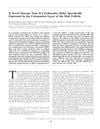TLDR A new keratin 6 type in mice explains why some mice without certain keratin genes still have normal hair and nails.
Researchers discovered a novel murine keratin 6 isoform, MK6hf, which explained why mice deficient in the known keratin 6 genes, MK6a and MK6b, did not exhibit hair and nail defects. Although most MK6a/b−/− mice died early due to tongue epithelium issues, about 25% survived to adulthood with normal hair and nails. The presence of MK6hf in hair follicles and nail beds of these mice suggested it compensated for the absence of MK6a and MK6b, as it is homologous to human K6hf, known for its expression in hair follicles.
149 citations
,
July 2000 in “Molecular and Cellular Biology” Keratin 6a is important for quick wound healing from hair follicles.
30 citations
,
October 1999 in “Differentiation” 75 citations
,
October 1999 in “Differentiation”  139 citations
,
December 1998 in “The journal of investigative dermatology/Journal of investigative dermatology”
139 citations
,
December 1998 in “The journal of investigative dermatology/Journal of investigative dermatology” K6hf is a unique protein found only in a specific layer of hair follicles.
32 citations
,
November 1998 in “Journal of Biological Chemistry” Mouse and human keratin 16 can both form filaments, with differences likely due to the tail domain, not the helical domain.
79 citations
,
October 1998 in “Genomics” Mouse keratin 6 genes evolved independently from human ones and are regulated differently.
175 citations
,
September 1998 in “British Journal of Dermatology” Keratin 17 gene mutations cause both steatocystoma multiplex and pachyonychia congenita type 2.
232 citations
,
July 1995 in “Nature Genetics”
3 citations
,
November 2022 in “Frontiers in Medicine” Onychopapilloma likely originates from the nail bed, not the nail matrix.
50 citations
,
July 2008 in “British Journal of Dermatology” 138 citations
,
March 2007 in “Experimental cell research” Only a few hair-specific keratins are linked to inherited hair disorders.
276 citations
,
January 2005 in “International review of cytology” 199 citations
,
January 2004 in “The International Journal of Developmental Biology” Hair follicle growth and development are controlled by specific genes and molecular signals.
29 citations
,
April 2003 in “Experimental dermatology” Human hair follicles grown in vitro maintain normal keratin patterns and structure.
36 citations
,
December 1991 in “Journal of Dermatological Science”
